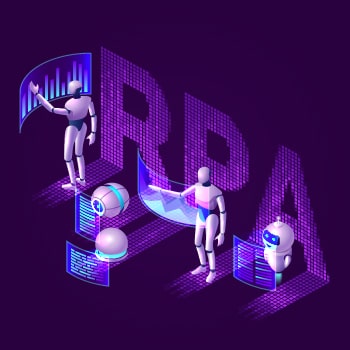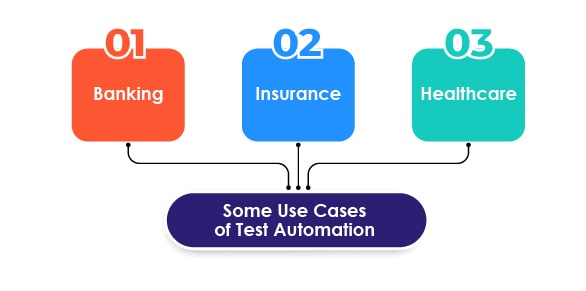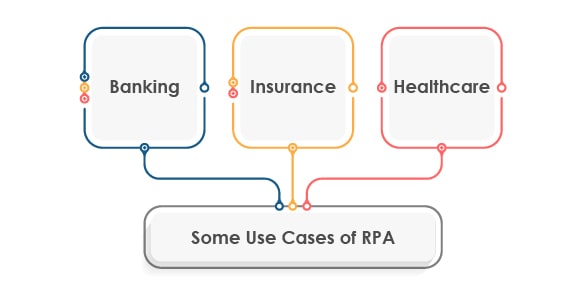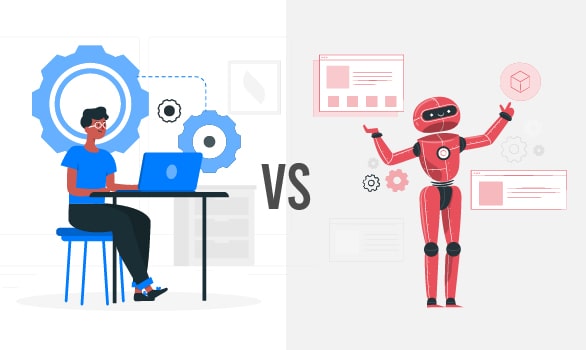
Introduction To Robotic Process Automation
Today, enterprises benefit widely by leveraging test automation to get faster releases, improve product quality, enhance productivity, and have a quicker ROI. While many other businesses are leveraging Robotic Process Automation Testing to automate their business processes, free up resources, improve operational efficiency and reduce manual tasks.
So effectively, RPA and test automation are the two strong pillars that businesses leverage to add on many benefits. But both have many differences with respect to their primary objectives, which have been detailed in this blog.
- Robotic Process Automation vs Test Automation
- An overview of Test automation
- What is RPA Testing?
- Test Automation Use Cases
- Robotic Process Automation Use Cases
- RPA vs Automation Testing
- Conclusion
Robotic Process Automation vs Test Automation
Test automation is the process that involves the usage of automation tools (Open source and Commercial) to develop test scripts based on use cases, help maintain test cases, execute them and finally analyze the test results. Software test automation ensures faster releases as processes are automated without much manual interference and delivers quality releases.
RPA Testing is best suited for enterprise business process automation to improve the operational efficiency of the processes as bots are employed instead of humans. The wider adoption of RPA can be attributed to increased efficiency with minimal human intervention as a software bot is trained to perform tasks and interprets actions seamlessly.
An overview of Test automation

Software test automation is an important aspect of DevOps-driven projects that facilitates continuous delivery and continuous testing. Test automation helps to assist developers and testers automate repetitive tasks to save time and increase test coverage. QA engineers use various automation tools and frameworks to validate the system’s functionality. If QA engineers were to execute these tests manually, the test results may take longer hours, be prone to errors, and might sometimes overlook bugs. Automation testing allows QA engineers to run the tests over different environments and devices repeatedly. As the QA and testing ecosystem has evolved, automation testing has become a critical aspect of quality assurance and delivers many benefits for enterprises.
1. Reduces cost:
Companies leveraging robotic process automation in software testing bring down the overall cost, resource utilization, and time and lowers overall QA costs up to 60%.
2. Faster Testing:
Automated testing needs little to no human intervention. Once set up, multiple tests may be executed at once, and teams can have detailed reports in less time and reduce QA cycle times by 80%
3. Faster feedback cycle:
Using test automation tools, QA engineers can provide feedback to the DevOps department faster and enhance the overall efficiency.
4. Faster time-to-market:
As the testing process is automated, automation engineers have more time to create better and more in-depth tests that increase the test coverage. Thus, time is saved with continuous testing, leading to shorter product launches and invariably results in faster time-to-market.
5. Larger Test Coverage:
As the repetitive tests persist unchanged and are periodically reused, test automation offers the flexibility to include additional tests and execute all of them, resulting in higher software quality. Consequently, as test coverage expands, it eliminates the necessity to skip or discard any test case.
What is RPA Testing?

RPA automation testing is the process of imitating an end-user on the app or software and performing the same tasks automatically. Artificial Intelligence and Machine Learning algorithms are implemented for the process, which learns the patterns from the actions of the users.
RPA software testing is achieved when bots with custom and diverse capabilities, adapt as per the user actions are then convert them into actions. These actions are then executed when required and without the user. Organizations use RPA due to its wide range of business benefits.
1. Operational efficiency:
RPA bots do not need a break and can work 24/7 and 365 days a year
2. Time-efficient:
RPA-based bots are highly efficient in bringing down the time taken to complete the designated tasks
3. Accuracy in results:
RPA bots deliver with a high accuracy rate and work without fatigue like any other machine-led tasks
4. Cost-effective:
RPA can reduce operational costs by automating key IT processes
5. Secure and reliable:
In the case of RPA, information is exchanged through secure paths. Hence, the chances of any data leakage or security breaches are minimal
6. Data and analytics:
Analytical data offered by RPA is error-free and can be considered for future business planning
7. Optimal Resource Utilization:
RPA efficiently manages resources by utilizing them consistently and occupying them only when required. This approach allows other processes to run smoothly without unnecessary resource allocation.
Test Automation Use Cases

Banking
• Authenticate customer login through both valid and invalid data
• Ensure that the user can update the balance and make deposits into the new account
• Verify that authentication works as expected and users are redirected to the dashboard
• Ensure all the links of different modules are functional
Insurance
• Ensure that customers can enroll in the policy benefits
• Verify that the application or software can make changes to the customer’s details and that the same is updated in the database
• Verify that users can cancel the policy
• Ensure that users can make payments through all modes like NEFT, Cheque method, etc.
• Verify that the claims are settled successfully.
Healthcare
• Ensure that members can be enrolled, reinstated and terminated.
• Verify that the correct details like account number or address are chosen for a member, service provider, and broker.
• Since healthcare apps generate reports across different formats such as HTML, PDF, and text, verify that the report is easily accessible to the respective users.
Robotic Process Automation Use Cases

Banking
• Optimize critical processes such as replacement of lost or stolen cards, charge processing billing and payments, and blocking cards on customer requests
• Automate the regular operations of the KYC process and improve security and compliance
• Improve the client verification process by fetching and displaying the required customer service documents on a single screen
Insurance
• Verify the NCB slab by referring to the status from previous policies
• Collect data from all the necessary sources to process claims at a faster pace
• Read and process data for details and update the database regularly
Healthcare
• Schedule patient and doctor appointments
• Collect data from each stakeholder and strengthen collaboration between internal and external stakeholders. Centralize the process to perform efficient auto-billing that promotes cost and time savings.
• Ensure the overall system is compliant with all the industry standards by identifying and removing the exceptions using bots
• Optimize claims processing by tracing and auditing payments using simplified bots
RPA vs Automation Testing
The following table compares RPA vs Automation Testing. It will help in understanding how these two technologies differ from each other.

S. No |
Area of difference |
Test Automation |
Robotic Process Automation (RPA) |
| 1. | Purpose | Effectively used for QA and testing. The main purpose of test automation is to ensure if software or hardware is working as per the predefined expectations and does not have any bugs or errors. | RPA is not dedicatedly used for automating business processes. RPA automates critical and mundane business processes, making them error-free and efficient. |
| 2. | Scope | Test automation works for a single application, and its features | RPA may be implemented for both the product as well as business processes. The overall flow may also run simultaneously in different applications |
| 3. | Technology | Test automation delivers results based on what the QA engineer writes test scripts. Test scripts are used as instructions for performing the tests | RPA bots are AI and ML-driven technologies that continue to learn from human interactions and perform process optimization tasks based on this learning in the form of a bot |
| 4. | Operational efficiency | Running test automation helps to increase effectiveness and ensures faster releases of quality products | Improves operational efficiency of the business as all the back-end processes are automated using bots |
| 5. | Scalability | Test automation may be executed across different environments like QA, Production, and Performance | RPA requires a single production environment |
| 6. | Key benefits | • Automates repetitive test cases • Faster bug detection and resolution • Improves test coverage |
• Removes manual and repetitive tasks • Delivers enhanced customer experience • Process compliance standards |
| 7. | Major tools | The choice of tools for test automation varies as per the project requirements. Some important automation testing tools are Selenium, UiPath, Appium, and RFT | Trending RPA tools are UiPath, Blue Prism, and Automation Anywhere |
| 8. | Ease of Usage | Based on the requirements and the tools used in the task, test automation may require a higher level of technical knowledge. Further, the technical skills needed to use the advanced test automation tools depend on the level of tests to be automated | Most of the RPA tools are designed in a way that engineers who implement the automation do not have to be program savvy |
Conclusion
Test automation and RPA Testing are used by enterprises to ensure faster and quality releases and automate business processes, respectively. These strategies revolve around automation and may sound similar but are different based on various factors and modes of working. Test automation aims to automate the test scenarios, while RPA strives to automate the business processes.
In the case of Robotic Process Automation Testing, The processes are automated by mimicking the tasks and actions performed by a human by leveraging AI and ML. Further, test automation works on test scripts created over strict rules, focuses on different software QA and testing scenarios, and leverages various automation testing tools. Leverage test automation and RPA testing services from next-gen testing services providers for superior outcomes.
Our Test automation framework- Tx-Automate
Test Automation Framework is a modular, reusable, integrated, and compatible framework with new components which can be easily accommodated without affecting existing components. The Tx-Automate architecture has BDD Framework, Plug & Play Framework mode, Test Management, Bug Tracking, Test Libraries, Browser Support, and Code Quality Checks.
Business benefits:
• Shorter design time: Over 40% reduction in test design time using pre-automated test scripts
• Reduced maintenance costs: Over 20% reduction in maintenance costs due to reusability of the framework across multiple applications
• Faster time to market: Up to 90% reduction in cycle time and improved test execution productivity leading to an overall 10% reduction in time to market
• Better decision making: Improved visibility due to comprehensive test reporting allows for more accurate strategic decisions
• Consistency of automation across the organization: Consistent and standardized automation across the enterprise results in better efficiency and utilization of resources
• Higher development productivity: Enabling process automation and suite integration within the development cycle, leading to better productivity
• Single framework with the capability to automate Web, Mobile applications, and APIs
Our UiPath RPA Framework (Tx Robot-led Test Automation Framework Powered by UiPath)
Important Features:
• DevOps ready
• Integrates with various third-party tools like JIRA, Jenkins
• Designed using Page Object Model
• Contains many components and integrations
Business Benefits
• Jumpstart automation within no time
• Loosely coupled DevOps ready framework that helps in integrating ALM Defect tracking and CI/CD tools
• Readily available libraries and reusable assets
• Accommodates new components and processes without impacting existing components
• Eliminates human-prone errors
• Robots developed with this framework are used to create complex automation test scenarios for web, mobile, desktop, and APIs
• Reduced Man hours by 90%
• Even manual testers can create test scripts using robots
Discover more
Get in Touch
Stay Updated
Subscribe for more info




